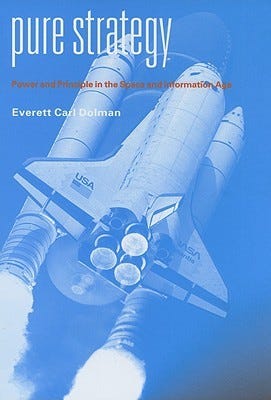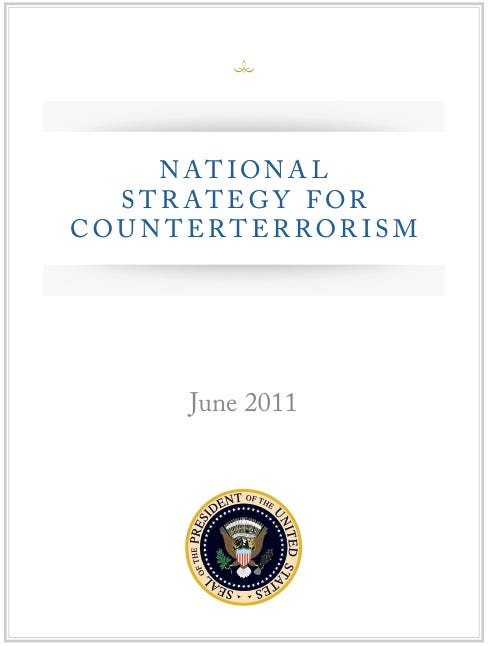Clausewitz reminds his readers, “In war the result is never final.” When the strategist considers counter terrorism, they must grapple with the larger focus of their aim, which is the act of building a bridge between two unlike elements: policy and military action. At the tactical level, counter terrorism is an action meant to culminate in an event that prevents, preempts, deters, defeats, or punishes a terrorist. However, at the strategic level, counter-terrorism is meant “as a plan for attaining continuing advantage.” In order for our counter terrorism strategies to remain effective, we must reject the strategic heuristic of specific end states, and instead seek continuing advantage towards a better state of peace. Ultimately, this also means rejecting a narrow theory of victory.
In June of 2011, the Obama administration published the most recent National Strategy for Counterterrorism. In this document, eight deliberate end states “articulate a framework for the success of the United States global counterterrorism mission.” Those eight interdependent end states are:
- Protect the American People, Homeland, and American Interests
- Disrupt, Degrade, Dismantle, and Defeat al-Qa’ida and Its Affiliates and Adherents
- Prevent Terrorist Development, Acquisition, and Use of Weapons of Mass Destruction
- Eliminate Safehavens
- Build Enduring Counterterrorism Partnerships and Capabilities
- Degrade Links between al-Qa’ida and its Affiliates and Adherents
- Counter al-Qa’ida Ideology and Its Resonance and Diminish the Specific Drivers of Violence that al-Qa’ida Exploits
- Deprive Terrorists of their Enabling Means
Pure Strategy
by
Everett C. Dolman
 There is one clear problem with this strategy: while these are admirable goals, they’re not actually end states. The critique is not just semantic. Rather, quite distinct from a paradigm that often equates strategy making and planning, the primary goal for a strategist is to qualitatively establish the bounds of action and set the conditions for the tactician. Do not misunderstand; end states are paramount to employing operational art, especially as a matter of objectives for the tactician to consider for victory. However, for the strategist, end states are anathema to the ultimate goal of advantage. Before we examine this more carefully within one aspect of the National Counterterrorism Strategy itself, let us understand the critique more deeply, and Everett Dolman illuminates this Clausewizian if paradoxical relationship between victory in tactics and advantage in strategy:
There is one clear problem with this strategy: while these are admirable goals, they’re not actually end states. The critique is not just semantic. Rather, quite distinct from a paradigm that often equates strategy making and planning, the primary goal for a strategist is to qualitatively establish the bounds of action and set the conditions for the tactician. Do not misunderstand; end states are paramount to employing operational art, especially as a matter of objectives for the tactician to consider for victory. However, for the strategist, end states are anathema to the ultimate goal of advantage. Before we examine this more carefully within one aspect of the National Counterterrorism Strategy itself, let us understand the critique more deeply, and Everett Dolman illuminates this Clausewizian if paradoxical relationship between victory in tactics and advantage in strategy:
It may seem intuitive that the strategist must have an end in mind, a goal to be achieved, at least to conceptually organize and make sense of the series of actions that are to be taken. Not so, and herein is another critical difference between tactician and strategist. Tacticians personify decisions made. The plan is owned by them, they are a part of it, responsible for the outcome, positive or negative. The results of these difficult decisions affect them directly and personally. Tacticians must act to bring events to conclusion, so as to extricate themselves from the conflict. When the war is over, they go home. When tacticians die, their battles end. Their goals were victory and, regardless of the outcome of the current battle or war, there will be no more for them. But military strategists act on behalf of an abstract concept—the state. They are the reification of the shared image. They plan on behalf of the state or military force and the actions they take continue to shape decisions long after they are removed from authority. The plan embeds itself into the fabric of the state, and the structure it creates becomes the responsibility of everyone in it. The strategist can never finish the business of strategy, and understands that there is no permanence in victory—or defeat. The real winner is the side that has established the framework for the next war (a decidedly realist strategic position) or the conditions for a lasting peace (an idealist outlook).
The National Counterterrorism Strategy lists one of its strategic goals as “Eliminate Safehavens.” Within this objective, the United States will “contest and diminish al-Qa’ida’s operating space through mutually reinforcing efforts designed to prevent al-Qa’ida from taking advantage of these ungoverned spaces.” Here, the strategist focuses the action of those who perform strategy. Those who make strategy should understand that “not every war leads to a final decision,” according to Clausewitz, and for the tactician they must either destroy the adversary, degrade their will to fight, or occupy the territory of their adversary. It is up to the strategist to determine not how precisely, but rather, to what purpose (although this may include constraints as to how) where the tactician “does strategy.”
In the interleaving period between June of 2011, when the National Counterterrorism Strategy was published, and May of 2013, there was great interest and debate over how the U.S. went about its strategic goal of “Eliminate Safehavens.” In May of 2013, the President of the United States partially released the Policy Standards and Procedures for the Use of Force in Counterterrorism Operations; until then, it was not publicly known in what way the strategist (or in this case, the policy maker) had constrained how the tactician could go about “doing strategy.” Of course, now we are well aware of the “drone campaign” that has occurred in various hotspots around the world specifically targeting dangerous leaders within al-Qa’ida. While this is but a single tactical category of action resultant from the U.S.’s interdependent and comprehensive strategy above, it conveniently highlights several limitations of a narrow “theory of victory” in strategic effect.
A MQ-9 “Reaper” remotely piloted aircraft sits on the flightline at Creech Air Force Base, NV. Photo by Lance Cheung, USAF (Wikimedia Commons)
First, if one notes the careful language of the National Counterterrorism Strategy, it merely seeks to “contest and diminish,” rather than occupy, or in strategic parlance, control the ungoverned spaces. This language implies, if not outright supports, strategic advantage over tactical finality that is often presumed via control. To wit it is strategically practical to grasp feasibility: “It is…not possible for America to simply deploy a team of Special Forces to capture every terrorist,” as President Obama stated in a May 2013 speech, and “even when such an approach may be possible, there are places where it would pose profound risks to our troops and local civilians—where a terrorist compound cannot be breached without triggering a firefight with surrounding tribal communities that pose no threat to us, or when putting U.S. boots on the ground may trigger a major international crisis.”
Second, the Policy Standards and Procedures for the Use of Force in Counterterrorism Operations provides a framework that, at its core, structures the considerations for policy with strategic continuation in mind rather than tactical culmination. Importantly, this balances the near-term gain, a hypothetical surgical strike against a target that poses a “continuing, imminent threat to U.S. persons,” against a long-term advantage that policy and the political goal of counterterrorism is aptly focused upon. Clausewitz highlights this balance when he parses that one must make clear both what “he intends to achieve by that war and how he intends to conduct it,” where “the former is political purpose; the latter its operational objective.” The former is strategy, the latter tactics. Clausewitz continues, and to the very point of the former, “[this] is the governing principle which will set its course, prescribe the scale of means and effort which is required, and makes its influence felt down to the smallest detail.” Understood in the right sense of things, no destruction or capture of any one, or several, terrorists is worth risking the enduring political objective of doing so. It is important to realize that Clausewitz is speaking here of real war vice absolute war, in which he is rejecting the notion of final victory. This goes to the very heart of those who are dissatisfied with the lack of finality of the drone campaign, or unsatisfied with approaches that circumspect the “mowing the grass” operational approach, rather than understanding it properly as a military means that contribute towards strategic advantage.
Finally, and most importantly, specific end states and victorious culmination preclude prudent adaptation to an emergent threat of terrorism. As the threat is constantly changing, and adapting, so appropriately shall our strategy to counter terrorism. Here the means of strategy “being done” will constantly change, both in function and degree, but that does not mean this is tantamount to strategic inconsistency. The consistency of the strategic counter terrorism approach is less impressed with terrain denied (or controlled), body count, or even specific actors killed or captured, but rather as the National Counterterrorism Strategy suggests, is focused upon “attaining a better state of peace” via politics by other means. Whatever means may suffice for politically expedient today, may not tomorrow, and thus our strategy must resist the stasis that an over-extended (and very tactical) theory of victory or specific operational (yet also tactical) end state might prescribe.
Scene from the movie “Zero Dark Thirty”
“Although we continue to pursue those components of our [counter-terrorism] strategy that have proven so successful in recent years in degrading al-Qa’ida,” the National Counterterrorism Strategy reminds us, “we must at the same time be prepared to adjust our strategy to confront the evolving threat prompted in part by that very success.” If our counter-terrorism strategy is appropriately focused upon bridging the gap between policy and military action, as strategy correctly should, then it must be one of “continuity and of change.” Dolman speaks to this point when he suggests the following:
The interplay of theory and reality forces the requirement for an adaptive strategy, one that sets its sight anew at each juncture. Strategy ‘uses the success of each battle and builds on it. The demands of strategy fall silent in the face of a tactical; strategy adapts to the new situation. Strategy controls the means required by tactics in order to be ready at the right time in the right place.’
A specific end, or a decisive counterterrorism theory of victory, is inadvisable towards creating an adequate or successful strategy. One should not apply the logic of tactics to strategy, or vice versa, and this requires us to reject a narrow and static theory of victory, particularly decisive victory, for the sake of continued success and advantage in the war against extremist terrorism posed by al-Qa’ida, its affiliates and adherents.

No comments:
Post a Comment